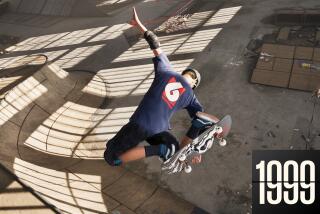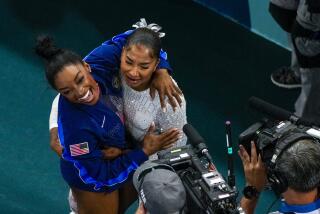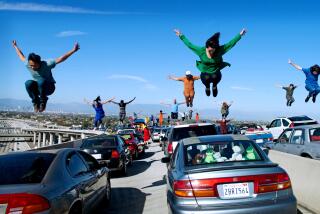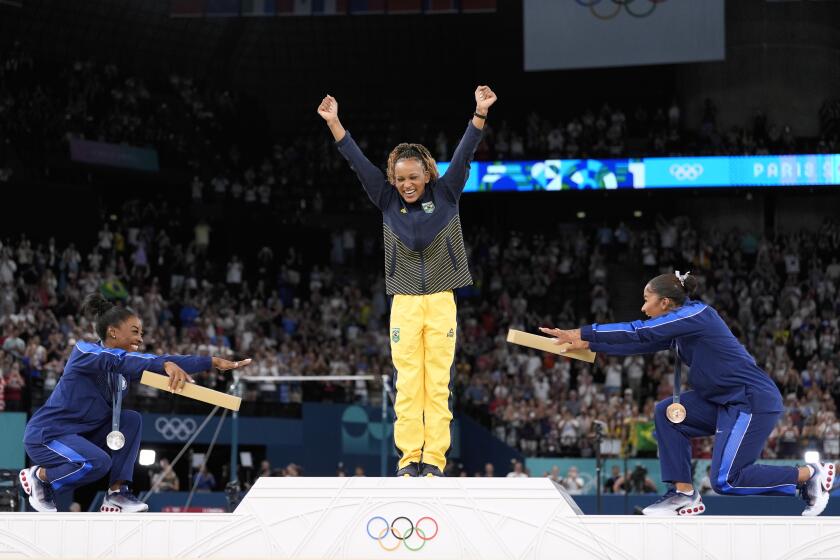The Inside Track : Synchronized Skating Team Is Trying to Get It Together
The 20 teen-aged girls have beaten dawn as they arrive at the Westminster Ice Palace. It is not even 5 a.m. yet. Cindi Perkins sets her alarm for 2:45 a.m. so that she can make the 90-minute drive from Oceanside. All the girls are chattering, though, wide awake, pony-tails bouncing, makeup perfect.
They have come to the skating rink, from Oceanside and Huntington Beach, Long Beach and Los Alamitos, Torrance and Bellflower, for their twice-weekly practice. The sport is figure skating, yes, but not what you’d expect. It is not singles skating, with tiny little girls doing eye-popping triple jumps. It is not pairs skating, where women can be thrown many feet into the air and, hopefully, get caught by a partner. It is not ice dancing, where the hardest thing is to find a male counterpart.
No, these 20 girls rush onto the ice together. They form rows, straight as arrows, as if they were in military formation. They hook arms, they tilt their chins, 20 chins, all at the same angle. The music starts. The 20 move. All together, a giant skating amoeba.
This is called synchronized skating and these 20 girls are members of the United Skates, Southern California’s only junior-level synchronized skating team.
Synchronized skating had been known as precision skating since the sport was created in 1957. To quote from the precision skating fan page on the Internet, “Heads, legs, arms and bodies must be synchronized and in unison. Formations must be accurate. Lines must be straight. Teams of skaters must perform a variety of types of footwork, group formations and skating maneuvers.”
Precision skating got a new name because it is trying to become an Olympic sport. It has been added to the 2002 Olympic program in Salt Lake City as an exhibition sport. Wanda Guntert, coach of United Skates, says that precision skating didn’t translate into German--Guntert isn’t sure how the translation went but it didn’t go well--and so synchronized skating it is.
Many little girls take up figure skating because of the Olympics, because they see a Kristi Yamaguchi, an Oksana Baiul, Tara Lipinski or Michelle Kwan, on television during the Olympics and then beg Mom or Grandma or somebody to take them to the ice-skating rink.
Jekia Burns, a 12-year-old seventh-grader from Long Beach watched Baiul in Lillehammer, Norway--”Oksana was so graceful and so pretty,” Jekia says--and she began pestering her grandmother, Deola Glenns, to take her skating. “I didn’t even know where a rink was,” Glenns says, laughing, “but after a year Jekia was still badgering me so I found one.”
Angel Gonzalez, a 12-year-old seventh-grader from Bellflower, started skating five years ago, she says, “because I did have hopes of being in the Olympics. And I still do!” Rebecca Hough, 13, from the Belmont Shores area of Long Beach, has tried singles skating and ice dancing because, frankly, she says, “I have dreams of being in the Olympics, now more as an ice dancer than as a singles skater because ice dancing is not nearly as competitive as [singles], so I was hopeful I would find a partner. Now that synchronized skating is going to be an Olympic sport, I am very excited.”
It is this Olympic dream that has played a large part in bringing the United Skates into being. Synchronized skating has been mostly an Eastern and Midwestern thing, the excellent teams all found way before you reach the Rockies.
Lindsay Meares, 13, from Huntington Beach, who is an excellent publicist, had sent off an e-mail promoting her team partly because, she says, she wanted to alert the rest of the country to a rising power in a new place and partly because she wanted to show how important it was to these 20 skaters to have this team, to have this new sport, so important that they will come to practice at 5 a.m.
Most of these girls also continue their singles training, taking singles lessons in the afternoons. They must study too, do homework, keep up grades. Sometimes the homework is done in the car, on the way from class to the ice. When you have to be up at 4 a.m. for synchro practice, you can’t stay up late doing homework.
As much as the skaters hope synchronized skating will become a full medal Olympic sport, Guntert hopes to see colleges add the sport. It is a good way, Guntert says, in this era where Title IX mandates that money and scholarships be divided equally between men’s and women’s sports at the university level, to bring extra women athletes into the college.
And more than that, it’s for all those little girls who grab on to an Olympic dream when they see a tiny Tara Lipinski earn a gold medal, who spend six or seven years taking lessons and learning jumps and who then find out that only two or three Americans can go to the Olympics. Or for those with one, big growth spurt that makes the jumping just too difficult. Synchronized skating offers a future. There is a team to be on, to bond with, to compete for.
“That’s so neat,” Meares says. “That’s the best part.”
*
Diane Pucin can be reached at her e-mail address: [email protected]
More to Read
Go beyond the scoreboard
Get the latest on L.A.'s teams in the daily Sports Report newsletter.
You may occasionally receive promotional content from the Los Angeles Times.







